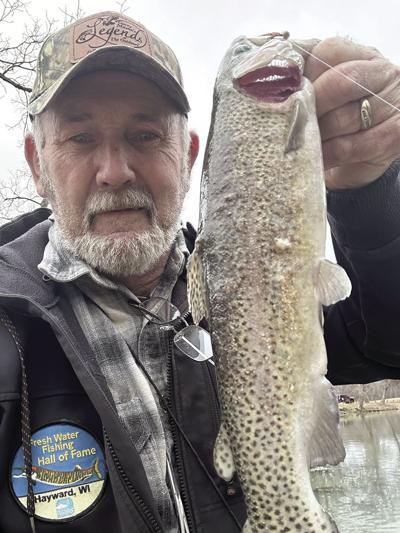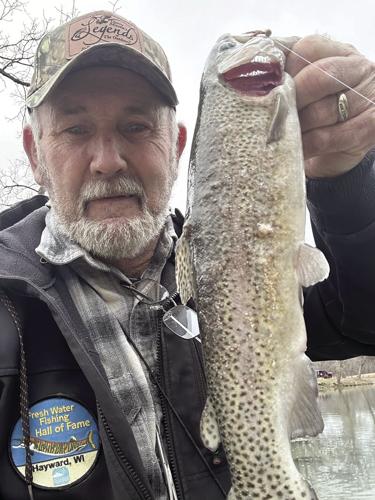Missouri’s four trout parks offer a winter catch and release trout fishing season. The popular fishing season began Nov. 8 and runs through February 10, 2025. A fishing license and an annual trout stamp are required to participate.
Each participating trout park stocks several thousand trout in their respective spring branches once the regular trout season closes for the year at the end of October. The extra fish gives anglers an opportunity to catch a lot of trout, even though they can’t keep them.
Massive floods in October had a negative impact on the parks, particularly Montauk State Park and Maramec Spring Park, which is owned by the James Foundation. Montauk is closed for the catch and release season, due to extensive damage and loss of fish.
Maramec Spring Park remains open despite the extensive damage the park sustained during the flood. “Volunteers helped us get the park cleaned up pretty quickly,” said James Foundation director Wes Swee. “We will be a while getting everything back in shape, but we will be working steadily to get it all done over the winter.”
The catch and release season remains open at Maramec Spring Park. And there are lots of trout to be caught and released. Many are small fish that escaped hatchery pools during the flood, but there is a good number of respectable fish as well.
Like so many people in the region, my wife, Dian, and I contracted the long lasting cold symptoms around Thanksgiving. I’ve been cooped up in the house for three weeks, and cabin fever has about done me in.
At long last I ventured outdoors and enjoyed a short trip to Maramec Spring. The spring branch ran a bit high and muddy. When I haven’t been to the park in a while, I have developed the habit of taking a variety of fishing equipment, both fly fishing and spin fishing gear, so that I can match the current conditions.
I arrived at the park at 2 p.m. A half dozen vehicles dotted the lower parking lot. Most anglers had given it up for the day.
I stepped out of the truck to survey the water situation. A brisk wind made the 50-degree temperature feel much cooler. I elected to fish spinning gear, because of the wind. I prefer fly fishing gear, but my energy levels were still quite low, and fishing with spinning gear requires far less energy.
I rigged an ultra-light spinning rod with 2-pound test line and attached a chartreuse colored RoosterTail with a gold spinner. Darker colors tend to work better in dark water. Too, I have discovered over five decades of trout fishing that gold blades tend to work better than silver blades.
Trout struck at the spinner often, but seemed to be short striking, and I only had two hook ups in the first ten minutes. I knew there were plenty of trout in the stream and with the right lure I should be hooking up every few casts.
I tried a variety of jigs with a small split shot 8-inches about the jig, so that I could cast farther. Again, strikes did not come often. To make matters worse, trout were hitting the surface steadily. I knew I had to make an adjustment to be able to catch fish.
I finally removed the split shot and tied on one of my all time favorite jigs, a 1/64th-ounce copper colored tinsel jig. Although I could only cast half the distance, I caught a scrappy 8-inch rainbow on my first cast.
Because I couldn’t cast over 30-feet with the light jig, I began targeting breaks in the current where trout would hide. There is lots of moss beds in the spring branch and many were slightly visible in the murky water. I began drifting my jig down the edges of the moss strands. It worked like a charm. Trout steadily darted from under the moss to slam my tiny jig.
I noticed a swirl between a narrow passage between a big rock and a moss bed. I pitched my jig perfectly. A big fish inhaled the jig as soon as it hit the water. The fish felt especially strong in the current.
I loosened my drag to be able to handle the bulky fish without breaking my 2-pound line. It made several powerful runs before I managed to turn the fish in my direction. It rolled to the top exposing a mottled-brown side, but it was not a brown trout. I quickly determined that it was a hefty smallmouth bass.
Maramec Spring branch is a wintering ground for smallmouth bass. They travel from many miles down river to reach the stable temperatures of the spring branch for the winter. The migration usually begins around the middle of October. They begin to disperse towards the end of February and head back to their river lairs.
I steadily caught rainbows on my copper-colored jig. I had trimmed the skirt so that it barely extended past the bend in the hook. With a minimal twitch as I slowly retrieved the jig, the skirt undulated like a swimming creature. It was more than the rainbows could stand. They clobbered my jig on practically every cast.
I fished for just over an hour and caught in excess of 30 trout. A fisherman using light tackle and the right offerings can expect to have hundred fish days.
I had one angler tell me that he could catch a thousand fish a day. But, what is fishing if you can’t exaggerate a bit?
Missouri’s four trout parks offer a winter catch and release trout fishing season. The popular fishing season began Nov. 8 and runs through February 10, 2025. A fishing license and an annual trout stamp are required to participate.
Each participating trout park stocks several thousand trout in their respective spring branches once the regular trout season closes for the year at the end of October. The extra fish gives anglers an opportunity to catch a lot of trout, even though they can’t keep them.
Massive floods in October had a negative impact on the parks, particularly Montauk State Park and Maramec Spring Park, which is owned by the James Foundation. Montauk is closed for the catch and release season, due to extensive damage and loss of fish.
Maramec Spring Park remains open despite the extensive damage the park sustained during the flood. “Volunteers helped us get the park cleaned up pretty quickly,” said James Foundation director Wes Swee. “We will be a while getting everything back in shape, but we will be working steadily to get it all done over the winter.”
The catch and release season remains open at Maramec Spring Park. And there are lots of trout to be caught and released. Many are small fish that escaped hatchery pools during the flood, but there is a good number of respectable fish as well.
Like so many people in the region, my wife, Dian, and I contracted the long lasting cold symptoms around Thanksgiving. I’ve been cooped up in the house for three weeks, and cabin fever has about done me in.
At long last I ventured outdoors and enjoyed a short trip to Maramec Spring. The spring branch ran a bit high and muddy. When I haven’t been to the park in a while, I have developed the habit of taking a variety of fishing equipment, both fly fishing and spin fishing gear, so that I can match the current conditions.
I arrived at the park at 2 p.m. A half dozen vehicles dotted the lower parking lot. Most anglers had given it up for the day.
I stepped out of the truck to survey the water situation. A brisk wind made the 50-degree temperature feel much cooler. I elected to fish spinning gear, because of the wind. I prefer fly fishing gear, but my energy levels were still quite low, and fishing with spinning gear requires far less energy.
I rigged an ultra-light spinning rod with 2-pound test line and attached a chartreuse colored RoosterTail with a gold spinner. Darker colors tend to work better in dark water. Too, I have discovered over five decades of trout fishing that gold blades tend to work better than silver blades.
Trout struck at the spinner often, but seemed to be short striking, and I only had two hook ups in the first ten minutes. I knew there were plenty of trout in the stream and with the right lure I should be hooking up every few casts.
I tried a variety of jigs with a small split shot 8-inches about the jig, so that I could cast farther. Again, strikes did not come often. To make matters worse, trout were hitting the surface steadily. I knew I had to make an adjustment to be able to catch fish.
I finally removed the split shot and tied on one of my all time favorite jigs, a 1/64th-ounce copper colored tinsel jig. Although I could only cast half the distance, I caught a scrappy 8-inch rainbow on my first cast.
Because I couldn’t cast over 30-feet with the light jig, I began targeting breaks in the current where trout would hide. There is lots of moss beds in the spring branch and many were slightly visible in the murky water. I began drifting my jig down the edges of the moss strands. It worked like a charm. Trout steadily darted from under the moss to slam my tiny jig.
I noticed a swirl between a narrow passage between a big rock and a moss bed. I pitched my jig perfectly. A big fish inhaled the jig as soon as it hit the water. The fish felt especially strong in the current.
I loosened my drag to be able to handle the bulky fish without breaking my 2-pound line. It made several powerful runs before I managed to turn the fish in my direction. It rolled to the top exposing a mottled-brown side, but it was not a brown trout. I quickly determined that it was a hefty smallmouth bass.
Maramec Spring branch is a wintering ground for smallmouth bass. They travel from many miles down river to reach the stable temperatures of the spring branch for the winter. The migration usually begins around the middle of October. They begin to disperse towards the end of February and head back to their river lairs.
I steadily caught rainbows on my copper-colored jig. I had trimmed the skirt so that it barely extended past the bend in the hook. With a minimal twitch as I slowly retrieved the jig, the skirt undulated like a swimming creature. It was more than the rainbows could stand. They clobbered my jig on practically every cast.
I fished for just over an hour and caught in excess of 30 trout. A fisherman using light tackle and the right offerings can expect to have hundred fish days.
I had one angler tell me that he could catch a thousand fish a day. But, what is fishing if you can’t exaggerate a bit?















